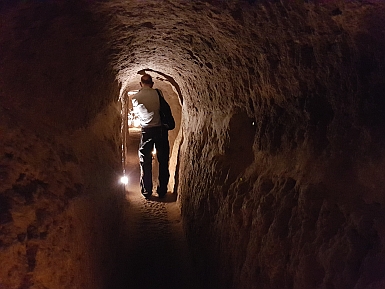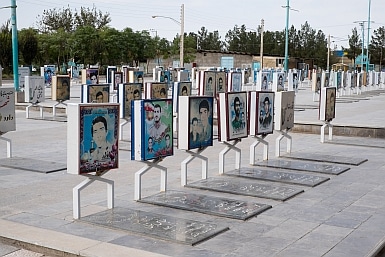Sunday Afternoon in the Maranjab Desert, Iran
Taking the advice of our Iranian Tour guide (we have finished the tour and are now travelling independently), we book a “Maranjab Desert Tour” for our free day in Kashan. Our driver and guide, who I’ll call Mehdi, arrives on time and walks us to his small and slightly battered Iranian manufactured sedan. Fleetingly I wonder why it isn’t the expected four by four off road vehicle we were promised.
Mehdi takes off at speed, weaving in and out of traffic, missing cars by centimetres. This is how it is in Iran, but Mehdi appears to be particularly aggressive in his driving. I wonder if this was a good idea.
Underground City Noosh Abad
Shortly, Mehdi pulls up outside an “Underground City”, one of the stops we’ll make on our way to the desert. He points to the entrance, indicating that he will wait for us with the other drivers standing alongside their “tour” vehicles.
The Underground City is located in Noosh Abad, about five kilometres from Kashan. It’s an Iranian National Heritage Site. Men dug the underground city by hand around 1500 years ago as means of escape from their homes when facing attack and invasion. The air cools as I descend the steps into a large underground hall. Children run around shouting, enchanted by the echoes of their voices.


Leaving the noisy hall, I walk through a series of interconnected passages and chambers, wondering at the skill and grit of those who tunnelled through the earth to create this shelter. Interestingly Ouee, as the city is called, was only discovered in 2006 when a local was digging a well (another account says a sewage ditch).
Sizan Castle
Sizan Castle is next on the itinerary. The crumbling mud brick walls surround an open central area and provide a wide view of the surrounding area. This castle, also on the Iranian National Heritage list underwhelms me. I’ve seen better, less run-down examples in previous weeks.


Shrine of Hilal ibn Alif
Now we pull up outside the Shrine of Hilal ibn Ali (the Shrine for the sons of Imam Ali). As is expected when visiting Shrines in Iran, women must cover themselves with a chador and I take one from the box inside the door. With my camera around my neck, I need help. It’s almost impossible to keep it from slipping off.
Feeling very self-conscious, I walk out into the beautiful courtyard. The predominantly teal blue tilework shines in the bright sunlight. Removing my shoes, I enter the women’s prayer area. Local women wearing the black chador (mine is white with a subtle floral pattern) sit praying or chatting. Some look up at me while others, engrossed as they are in their devotions, hardly notice me at all. This is not the time or place to start a conversation, and I leave quietly.

Iranian Martyrs
Leaving the shrine, I come across row upon row of portraits facing me. I have become accustomed to seeing posters and murals of the so-called martyrs when entering a town, village or city, but the sheer number of male faces here overwhelms me. These men died during the Iranian revolution, the Iran/Iraq war and possibly now the Syrian war.
Around the world cemeteries paying homage to war dead, but somehow seeing the faces of these mostly young men adds a poignancy to my experience as I leave the shrine. Even now, as I write about this, I get a lump in my throat thinking about the futility of war.


The Maranjab Desert
As the terrain becomes increasingly barren, the sealed road makes way for corrugated dirt occasionally covered in thick sand. Finally, we are entering the Maranjab Desert. Mehdi doesn’t slow down. Confident of his driving ability and oblivious of potential damage to his small sedan he races along overtaking slower vehicles and hooting at motorbikes and busses in his path. As the car slews within centimetres of a parked bus, Mehdi hoots forcefully, muttering under his breath. This drive would be much more pleasant if we were taking our time.
The Iranian Weekend
Mehdi obviously knows the desert well. His knowledge of the side roads and short cuts keeps us away from most traffic which is surprisingly heavy. Today is Friday, (our Sunday and the end of the Iranian weekend) and people from as far afield as Tehran have come to the desert for off road driving, for picnicking and to experience the fresh desert air. There are four-wheel drives, motorbikes (most not suited to off road riding), large tour busses and regular sedans like ours.


We pass a rudimentary campsite set up not far from the road. There are no facilities to speak of but the lure of a night in the desert for Iranians is strong. I see a camel in the distance, but there is no stopping Mehdi until we reach the official desert entry where an entry fee is payable.
Meeting Locals in the Maranjab Desert
Soon, the road climbs to a popular lookout. Mehdi parks away from a group of motorcyclists on one side and a family group picnicking opposite. From the edge of the lookout, the view stretches for miles, a dust cloud following the curve of the road.
I approach the motorcyclists. They have spent the day riding up and down the steep slopes, tinkering with the engines when they fail (which they do) and appreciating the freedom of riding off road. The young men sit beside a campfire where a blackened pot of tea keeps warm. One offers his shisha pipe, another offers tea. Typical Iranian hospitality.


After a brief chat, I wander across to the family group. A woman makes eye contact and calls me over. Immediately I am surrounded, offered tea, sugar and even lunch from a half-consumed plate of food. Using the only common language we have – sign language and a few newly learnt words in Farsi – we all enjoy a wonderful chance meeting in the desert. An experience that I will remember always.


Climbing the Dunes
Mehdi points to his watch. The sand dunes beckon and we park at the foot of a large dune. There are few people here now and I trudge up an unspoiled dune, my feet sinking into the fine sand. Once at the top, I sit down, taking in the expanse of sand rippled by the wind while absentmindedly dribbling the cool sand between my fingers.
The sight of a young woman wearing tight jeans, short sleeveless top with exposed midriff and no head covering is jarring. I haven’t seen so much skin or hair in weeks. She waves as she poses for photographs. A local, probably from Tehran, she feels safe to disrobe here.


The unmistakeable sound of spinning wheels causes me to turn my head. The girl and her friends drove up the dune instead of walking. Now their four-wheel drive is stuck. The more they rev the engine and spin the wheels, the deeper the chassis sinks. Walking back down the dune to our waiting car, I pass two men carrying spades. They have a tough job ahead of them.
Visiting the Salt Lake in the Maranjab Desert
Back in the car, we pass a truck carrying salt. Then Mehdi drives off the road and onto the tessellated pattern formed on the huge Salt Lake. I turn around in a slow circle, staring at the expanse of the crusty lake, then bend down to taste the salt. The lake is not always dry and when wet, it’s a sea of sludge. Mehdi opens his boot and takes out a thermos, cups and a water melon. A welcome refreshment at this stage of the journey.


The sun has set and the light is fading. We decide to skip the Caravanserai, having already stayed in one previously, and make our way home. Mehdi’s driving terrifies me even more in the increasing darkness. The traffic is heavy with day trippers returning home.
A young man stands next to his stranded motorbike waving a torch to warn oncoming traffic. Mehdi scarcely misses him. Five camels stand one behind the other at right angles to the road patiently waiting for an opportunity to cross. I’d love a photo, but there’s no stopping Mehdi.
At a service station on the edge of the desert, mechanics attend to a number of broken-down four-wheel drives. The desert and Iranian driving habits have taken their toll. Motorbike riders stand forlornly beside their broken-down bikes, hitching a ride. Was their weekend worth it?
The Maranjab Desert – Was it Worth it?
My tour of the Maranjab Desert was something special, falling as it did on an Iranian Sunday. It was definitely worth it. Touring the Desert during the week will be completely different experience. The roads will be quiet, the dunes empty.
Given a choice I would go back on a Friday (our Sunday). It was a total buzz experiencing and being a small part of what Iranians do on the weekend. But I could have done without the crazy dangerous driving.

Really enjoyed this! …Mehdi makes me nervous just hearing about his antics. Thank you.
Thanks Suzanne. His driving was a nightmare.
Ditto – what Suzanne said! I can just imagine how you and Bronek were feeling in the racing car. But of course you had a wonderful experience, including interacting with Iranians.
Thanks Karen. Just writing about it helped me to relive the experience.
Thank you, Joanne, for sharing such a descriptive travel experience. Although I felt the white knuckles, there was no mention of the security of seat belts or air bags–hah, as though that would matter! I was so relieved to hear that it was definitely worth it…
Haha. Not sure about airbags but I certainly had my seatbelt on. I seem to remember that the door handle came off in my hand and I had to wait to be let out!
The passageways of the underground city look narrow and restrictive. Definitely something to be said for their construction to be standing 1500 years later.
The Maranjab desert looks like a happening place, the dunes and Salt Lake look vast. I love your photographs.
Thanks Bernadette. We were lucky to experience the desert on a weekend. Certainly was ‘happening’.